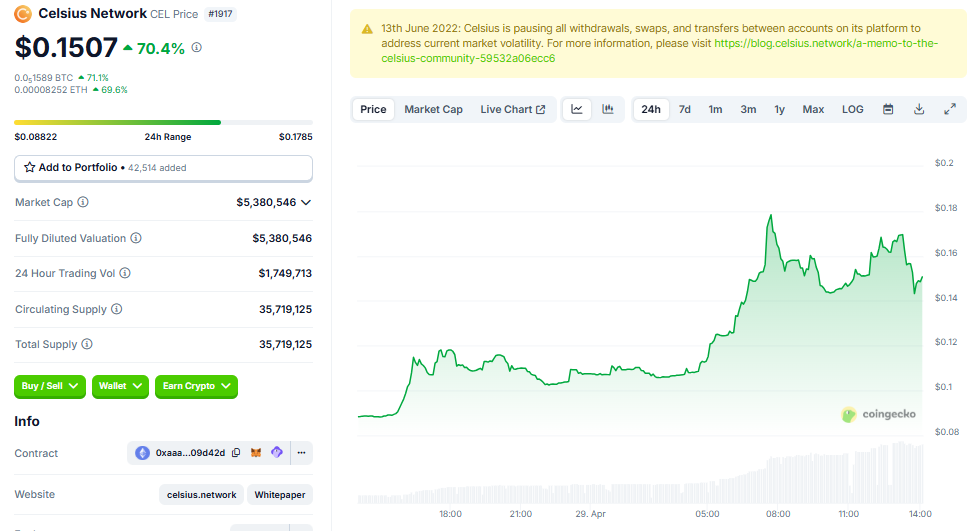-
Former Celsius CEO Alex Mashinsky faces a potential 20-year prison sentence for his role in a $7 billion fraud scheme, intensifying scrutiny on crypto governance.
-
Despite ongoing legal challenges, the Celsius (CEL) token has experienced a significant 70% increase, now valued at $0.1507, raising eyebrows among investors.
-
As Mashinsky’s sentencing approaches on May 8, multiple regulatory agencies are involved in his case, highlighting the urgent need for reform in the crypto industry.
Alex Mashinsky’s looming 20-year prison sentence for orchestrating a $7 billion fraud hasn’t deterred Celsius (CEL) token investors, who have seen a 70% surge in value.
CEL Token Rises Despite Legal Woes: Analyzing Market Reactions
The U.S. Department of Justice’s recent request for a 20-year sentence for Alex Mashinsky has shocked the crypto community. As outlined in a memo filed on April 28, the prosecution described his actions as “deliberate, calculated” fraud that resulted in substantial financial losses for investors.
Interestingly, the CEL token has defied expectations by climbing over 70%. Current data from CoinGecko reveals that CEL is trading at $0.1507, prompting discussions about investor sentiment amidst legal turmoil.

Celsius Network (CEL) price performance. Source: CoinGecko
This rise comes five months after Mashinsky’s guilty plea, when he faced multiple charges, including market manipulation linked to the CEL token. The allegations of commodities fraud and price manipulation were central to the Celsius collapse, stirring significant concerns within the crypto market.
Despite his guilty plea, Mashinsky has notably refused to take responsibility, attributing blame to external factors such as regulatory environments and market volatility.
The DoJ stated, “Mashinsky’s actions were not merely negligent; they were intentional acts designed to deceive stakeholders for personal gain.” This sentiment resonates as various agencies, including the SEC, are scrutinizing not only Mashinsky but the larger framework within which cryptocurrencies operate.
Regulatory Fallout: A Broader Implication for the Crypto Space
The root of Mashinsky’s challenges began in July 2023 when the SEC initiated legal proceedings against Celsius and Mashinsky, alleging severe misrepresentations that affected thousands of investors. The agency’s points of contention included:
- Misrepresentation of the core business model and associated risks.
- Falsifications regarding financial stability and customer assets.
- Direct manipulation of CEL token market valuations.
Besides the SEC, numerous other regulatory bodies, such as the CFTC and FTC, have leveled charges against Mashinsky, cementing a climate of heightened regulatory scrutiny in the crypto sector. As noted by industry analysts, “The convergence of these charges paints a troubling picture for regulatory compliance in crypto.”}
Critically, the fallout from Mashinsky’s actions has sparked debates regarding necessary reforms in regulatory frameworks governing cryptocurrency and decentralized finance. Calls for better oversight and transparency are gaining traction among lawmakers and stakeholders.
Next Steps: Victim Compensation and Future Considerations
Amid the arduous legal battles, efforts to compensate victims have also come into focus. Celsius has been engaged in measures to recover funds for defrauded customers. One such initiative includes unstaking the platform’s Ethereum (ETH) holdings to facilitate timely refunds.
According to a statement from Celsius in January 2024, “The significant unstaking activity will unlock ETH to ensure that overdue distributions are made to creditors,” demonstrating an ongoing commitment to addressing past injustices.
Moreover, Celsius has recently announced a secondary payout to creditors, amounting to $127 million in Bitcoin (BTC) and U.S. dollars, contingent upon eligibility criteria, reinforcing a push toward financial restoration for affected parties.
As Mashinsky’s sentencing approaches on May 8, the legal landscape will undoubtedly evolve, reflecting broader implications for not just the Celsius Network, but the cryptocurrency industry at large. If the court agrees to the recommended 20-year sentence, it could symbolize a pivotal moment in the ongoing battle for accountability in the fast-evolving world of digital assets.
Conclusion
The case against Alex Mashinsky serves as a critical reminder of the pressing need for regulatory clarity in the cryptocurrency landscape. As investors navigate the complexities introduced by this high-profile fraud case, the resilience of the CEL token amid legal challenges raises essential questions regarding market sentiment and the future direction of crypto assets. The outcome of Mashinsky’s sentencing could set important precedents, shaping how future misconduct is addressed across the digital finance ecosystem.
